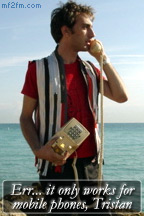 Ofcom has recently published a leaflet outlining how mobile subscribers can go about maximising their mobile signal with a view to getting the best possible coverage. The leaflet covers issues such as checking coverage first, before buying a phone (shops have on-line coverage checkers available), trying out different operators (by testing different SIM cards) and has a few technical measures such as the use of Femtocells (tiny mobile base stations you can install in your own home) and UMA (carrying your voice traffic over WiFi when you're in the coverage of a suitable hotspot).
Ofcom has recently published a leaflet outlining how mobile subscribers can go about maximising their mobile signal with a view to getting the best possible coverage. The leaflet covers issues such as checking coverage first, before buying a phone (shops have on-line coverage checkers available), trying out different operators (by testing different SIM cards) and has a few technical measures such as the use of Femtocells (tiny mobile base stations you can install in your own home) and UMA (carrying your voice traffic over WiFi when you're in the coverage of a suitable hotspot).This is all well and good, and reasonable advice, but it doesn't cover how you might go about getting a better signal if you are stuck in an area with poor coverage. So here's the (new look!) Wireless Waffle guide to practical things you can do to get a better signal (and things that don't work).
 Get high! By far the best way to improve your chances of getting a good signal is to get your phone as high as possible. Signals upstairs will be better than signals downstairs. Signals at the top of a hill will be better than at the bottom. Standing on the roof of your car will get a better signal than sitting inside it (not recommended if you are a bit on the heavy side). Height is the number one way to boost your signal.
Get high! By far the best way to improve your chances of getting a good signal is to get your phone as high as possible. Signals upstairs will be better than signals downstairs. Signals at the top of a hill will be better than at the bottom. Standing on the roof of your car will get a better signal than sitting inside it (not recommended if you are a bit on the heavy side). Height is the number one way to boost your signal.Get out! The Ofcom paper mentions this too, but doesn't point out how big a difference it can make. Buildings can shield mobile signals by anything up to a factor of 50. Standing outside will circumvent this shielding and can make a big difference in your chances of success.
Get moving! Buildings not only shield signals inside them but can block signals from passing through them. Other big obstructions such as gasometers, walls, and even trees and cars
can also block signals. As you are unlikely to know which direction the mobile signal you are trying to receive is coming from, you may inadvertently be stood in a position where it is being blocked. Move around (in particular walk around a building) whilst checking the signal on your phone to see if there is a spot where it suddenly comes to life.
 Get naked! Whilst we would love to see people walking around buildings in the nude to try and get a better phone signal, by this we mean taking off any covers, shells or other accoutremenets which adorn your phone. Some covers can contain metal elements which can deflect mobile signals, especially if they end up covering up the antenna on your phone. Operating your phone 'naked' will ensure that it's antenna is not blocked or covered in any way and can further improve performance.
Get naked! Whilst we would love to see people walking around buildings in the nude to try and get a better phone signal, by this we mean taking off any covers, shells or other accoutremenets which adorn your phone. Some covers can contain metal elements which can deflect mobile signals, especially if they end up covering up the antenna on your phone. Operating your phone 'naked' will ensure that it's antenna is not blocked or covered in any way and can further improve performance.Get clear! Most electrical devices, especially computers, TVs, set top boxes and other electronic gizmos give off weak radio interference. The amount they give off is limited by law, but in close proximity it can be enough to upset mobile reception. Make sure you are as far as possible away from any electronic equipment and the interference they generate should be too weak to cause reception problems.
Get plugged in! If your phone has option to connect an external antenna (such as via a car-kit) it might be feasible to connect an free-standing aerial (such as these) to it. The antennas inside phones are a compromise in size, designed to peform as well as possible given the small space in which they have to fit. Plugging in a proper, full-size, external aerial will boost signals, especially if the aerial concerned is high up, outside and clear of any blockages.
Of course, these are the easy answers. There are some more technical solutions that require a bit of effort, like the soup can booster antenna (no, not two cans and piece of string) which really work. As well as things that do help, there are a number of things that don't...
 Power Strip Antenna Boosters and similar devices that you stick on your phone that claim to be able to improve its performance. Anything that doesn't plug into your phone but just sticks to it is highly unlikely to do anything other than leave a sticky patch when you remove it.
Power Strip Antenna Boosters and similar devices that you stick on your phone that claim to be able to improve its performance. Anything that doesn't plug into your phone but just sticks to it is highly unlikely to do anything other than leave a sticky patch when you remove it.Passive repeaters are a bit of a grey area. Properly installed they may be able to provide some boost in signal indoors, by taking the signal that is received outside and relaying it to the inside. The increase is only likely to be noticeable if you mount the external antenna as high as possible, use very high quality cable to connect the two ends, and stand right next to the internal antenna.
Active repeaters are also a grey area, but for a different reason. They do actually work, and can improve mobile signals if properly installed. But, and it's a big BUT, they are illegal to operate. The only people licensed to use them are the mobile operators themselves. Anyone else using one is breaking the law. Further, if they are badly installed, they can cause interference to the mobile networks actually making reception significantly worse, not just for you, but for everyone else in the area too!
So hopefully you now have a much better idea of what works and what doesn't and can amaze your friends by shouting out the mantra of 'get high, get moving, get naked and get clear' if they are suffering reception problems. They are sure to understand what you mean as you couldn't possibly be misinterpreted, could you?
2 comments
( 1876 views )
| permalink
| 



 ( 3.1 / 129065 )
( 3.1 / 129065 )




 ( 3.1 / 129065 )
( 3.1 / 129065 )

